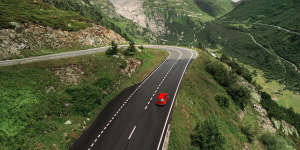Many cities in those countries have low emission zones (LEZs) with access restricted to certain vehicles based on their emissions. In France the vehicle’s emission level is identified by a Crit’Air sticker and only the owner of a vehicle can apply for it,not the hirer.

Your hire car should bear a special sticker that allows you to drive through Europe’s Low Emission Zones.Getty Images
The vehicle you hire in France should have a sticker supplied but check before you commit because the fine for entering an LEZ without the correct sticker can be costly. Most European countries appear to accept stickers issued in other countries as proof of compliance. In other words,the Crit’Air sticker should be sufficient to enter LEZs in all the countries you’ll be visiting.
Although many drivers ignore the speed limit and sit on 150km/h on most European motorways,flout the speed limit when you drive through towns and villages,and you can expect to cop a big fine. In Austria you need a motorway permit sticker,a “Vignette” or “Pickerl”,attached inside the windscreen. The stickers are available for varying periods starting from 10 days and most filling stations sell them. Get one as soon as you cross the border.
When approaching motorway pay stations,have two or three different credit cards ready to use because you never know which one is going to work. You need an international driving permit and a physical rather than a digital licence. Google Maps makes wayfinding easy,although I prefer Waze since it reorients itself to take account of the direction of travel. It also warns you about approaching speed cameras.
My partner and I are planning a five-week holiday to northern Europe in winter,including Finland and Sweden,to see the Northern Lights. It was suggested that we should consider spending a few days in and around Reykjavik and that we should hire a car to get around.
F. Nixon,Brunswick East,Vic
With five weeks to spare,you’ve got an excellent chance of seeing the Northern Lights. However I have reservations about spending all of that time in the Nordic countries in winter. As well as being severely cold,winter days are short and that impacts what you can do during daylight. In Stockholm,the sun sets at 2.55pm on December 1,just 6 ½ hours after sunrise,an hour less by the time the winter solstice rolls along.
Reykjavik’s winter days are shorter by about an hour and that makes Iceland a problematic winter destination. As well as the Nordic countries,you might consider splitting your holiday to defrost in warmer climes,and Sicily,Andalusia and Portugal would be my choices.
I wish to hire a car and travel the Persian Gulf countries with my son. The route would be from Kuwait to Muscat via Bahrain,Doha,Abu Dhabi and Dubai. Is this possible?
K. James,Clontarf,NSW
It is possible but there are a few things to be aware of. You need an international driving permit as well as your physical licence. Make sure you have the vehicle’s registration documents. You will need a visa for Oman since this is a separate country from the UAE and if you drop your hire car in Muscat expect to pay a hefty one-way fee. You might also need extra insurance cover for Oman,check with your hire-car operator.
Driving in Dubai requires a tag,which can be purchased online or at service stations and must be fixed to the windscreen. Salik is Dubai’s electronic toll road system,using RFID technology to automatically deduct a fee of AED4 ($1.70) when a vehicle passes through a toll gate. The cost of the tag is AED100 ($42.30). Salik is also available as an app. Abu Dhabi has a similar system known as Darb,with toll gates located on the main bridges leading to the city. If you want to drive through a toll gate you need to set up an account with the officialwebsite or download the app. The process of creating an account is complicated. However,the toll only applies during peak periods:7am to 9am and 5pm to 7pm,Saturday to Thursday. Avoid those times and you dodge the toll.
I would like to take my whole family to a location that is a direct flight from Munich (two adults and three children),and a direct flight from Sydney (six adults and three children). For example,Vancouver,Tokyo,Singapore,Los Angeles,with attractions for children aged 5 to 14,but not too expensive. Timing is second half of April.
A. Shepherd,Elizabeth Bay,NSW
My first choice would be Sri Lanka,however there are no non-stop flights from Munich to Colombo. The closest airport with a non-stop flight is Frankfurt and that might be out of the question.
Another good option is Vietnam,and there are non-stop flights from both Munich and Sydney to either Ho Chi Minh City or Hanoi. Vietnam has lovely beaches,gorgeous scenery,hill tribes in misty mountain villages,the stunning seascape of Halong Bay,ruined Buddhist cities and romantic remnants from colonial times.
There are plenty of adventures to keep the children entertained,sensational food,some stunning hotels and prices are reasonable,which is not the case with many of the other cities and regions that are accessible on non-stop flights from both Munich and Sydney. If you were to choose Tokyo,Singapore or anywhere in North America,for four-star hotel accommodation,meals and entertainment for your group of eight adults and six children you could expect to spend at least $3500 a day.

Travel advice is general;readers should consider their personal circumstances.